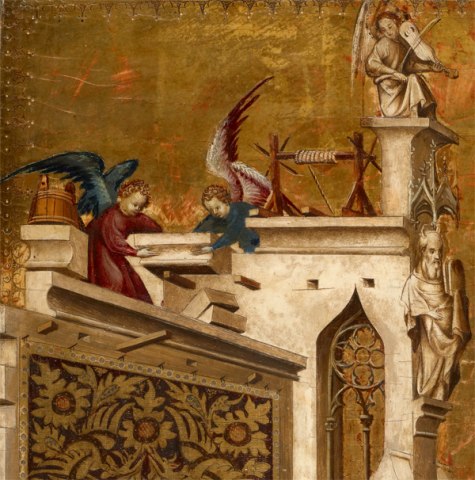C. Mind and matter

Fig. Angels building a church. The annunciation of Mary with musical angels (detail). Master of Heiligenkreuz (c. 1380). Part of a Diptych from the Abbey of Heiligenkreuz. © Kunsthistorisches Museum Vienna, with permission. The assistance of angels in the construction of a church, and their musical practice, connects these material arts with God’s order of the cosmos.
The essays in this lead topic demonstrate in different ways how music brought together practical, material and theoretical thinking. Organ-building and organ music, which required technical as well as mathematical skills, were extensively promoted in Austria; from Paul Hofhaimer (1459–1537) onwards, local organists were also celebrated composers. Musicians from the region came from the 14th century in contact with music in the western European styles of „Ars antiqua“ and „Ars nova“ (13th and 14th centuries) of which surprisingly many vestiges have been uncovered in the holdings of Austrian libraries today. In Austria, too, traditional music theory aimed at teaching plainchant was expanded to include the principles of mensural, polyphonic music, whereby theorists from Bohemia played a godfatherly role. The numerous depictions of angel consorts in the region could be considered iconographic evidence of the cultivation of instrumental music - but their theological and artistic contexts must be taken into account. Notations of polyphonic music in Viennese sources from around 1440 follow local as well as supraregional notational principles, providing information about the training and working methods of their users. The same sources allow an insight into compositional processes, even possibly into the tricks of the trade of musical “workshops”.
The essays marked with * are not yet available online.
Orgeln und Orgelmusik in der Region Österreich
Klaus AringerArs antiqua und Ars nova: Unbenutzte Fragmente - praktische Vorbilder?*
Marc Lewon, Reinhard StrohmSpekulative Musiktheorie und Chorallehre
Alexander RauschOrganisten und Kopisten
Bernhold SchmidKompositorische Lernprozesse*
Reinhard Strohm